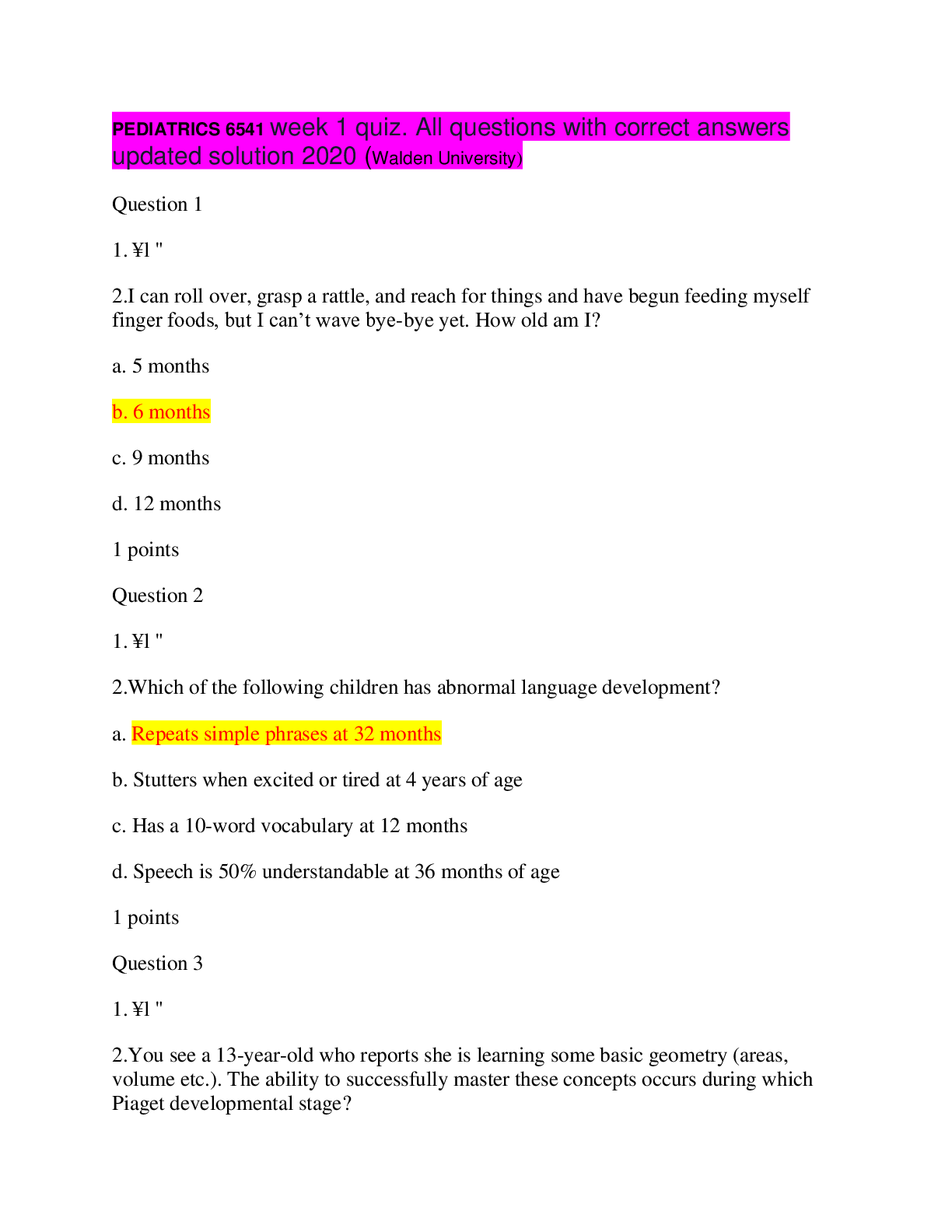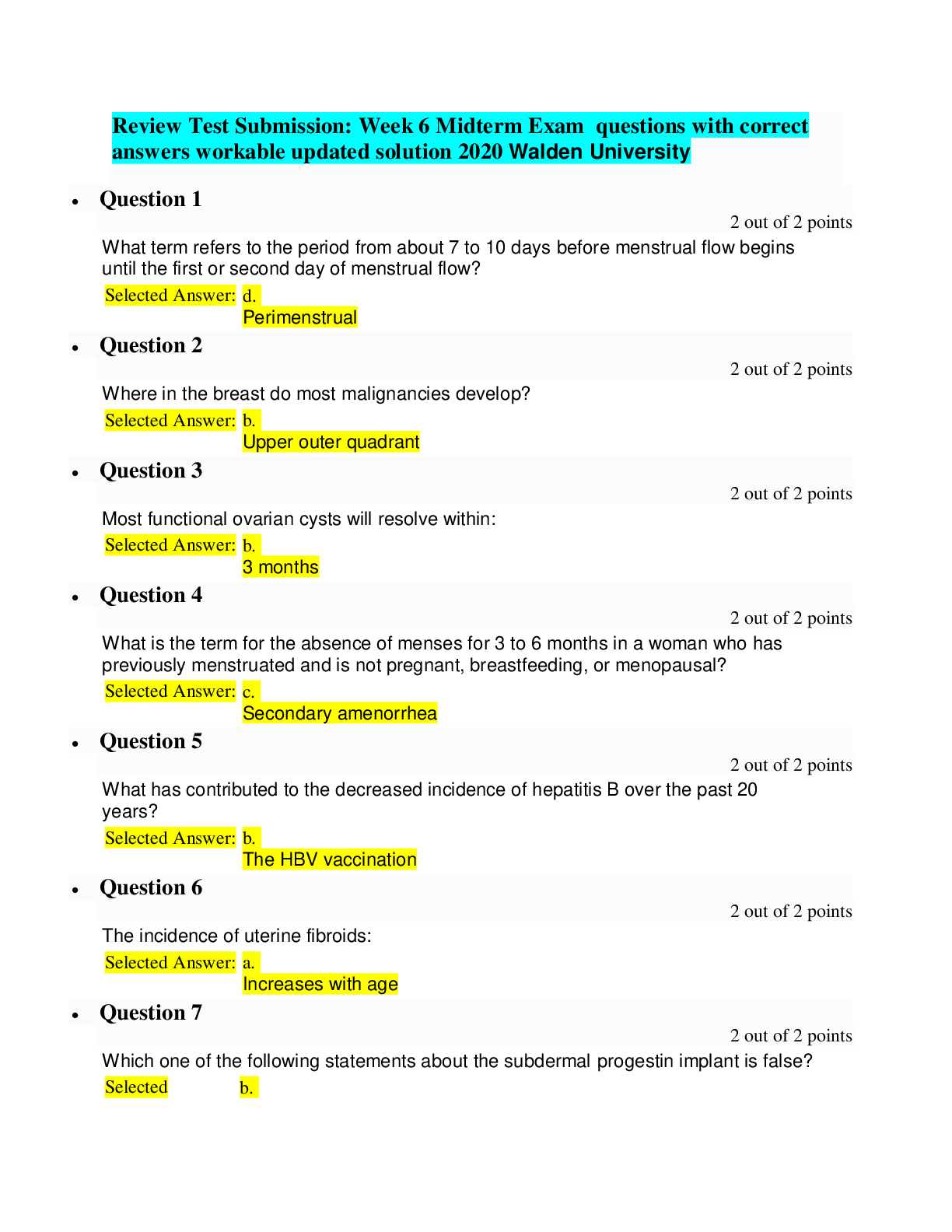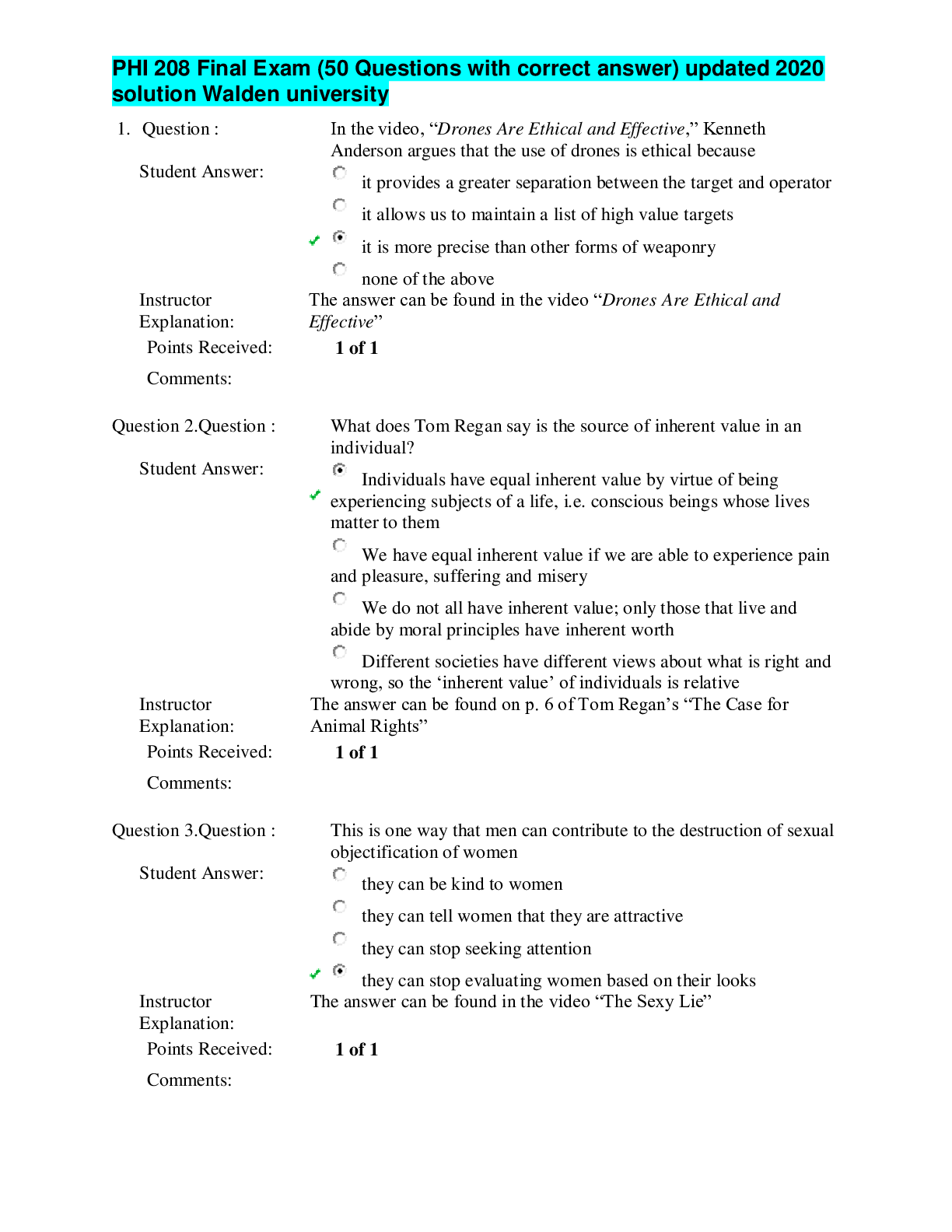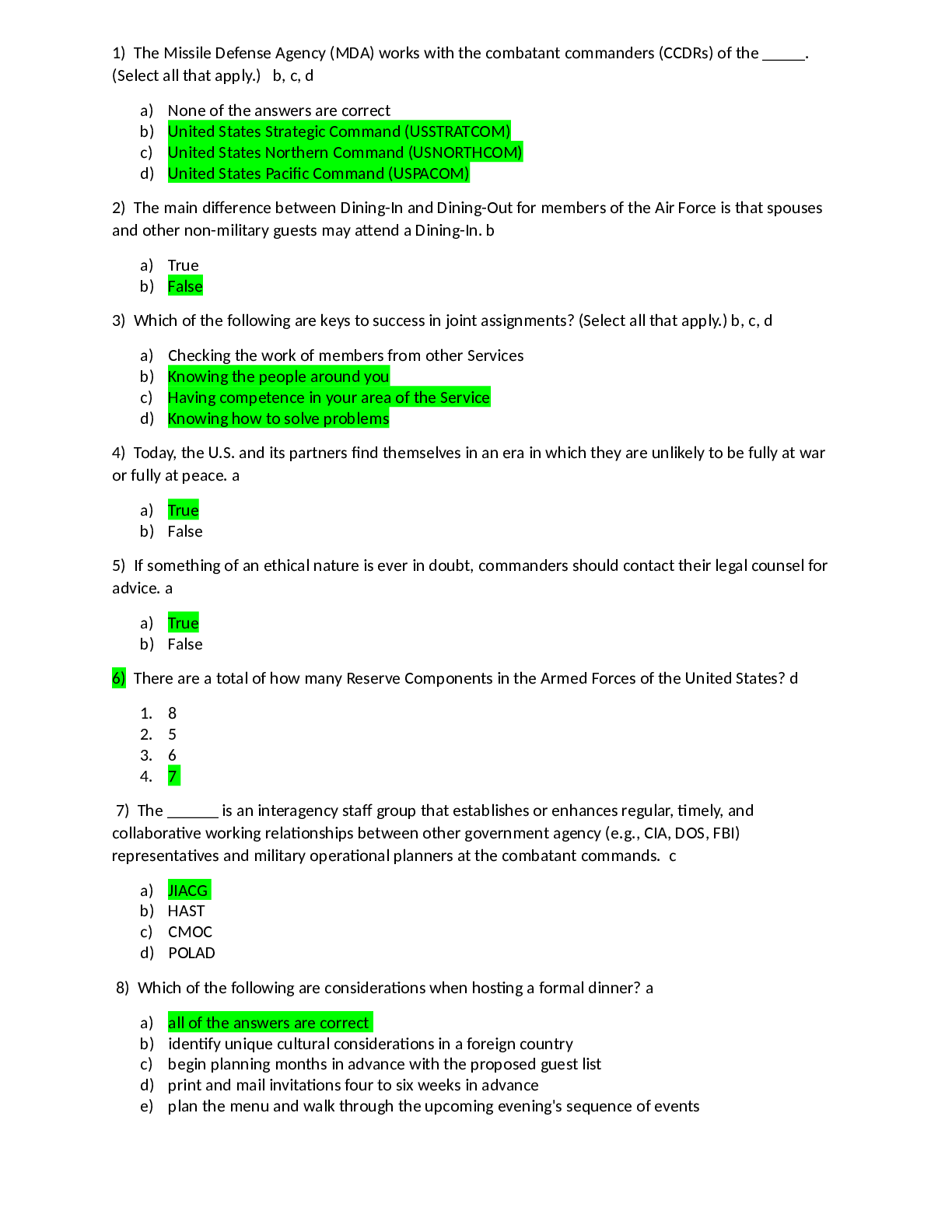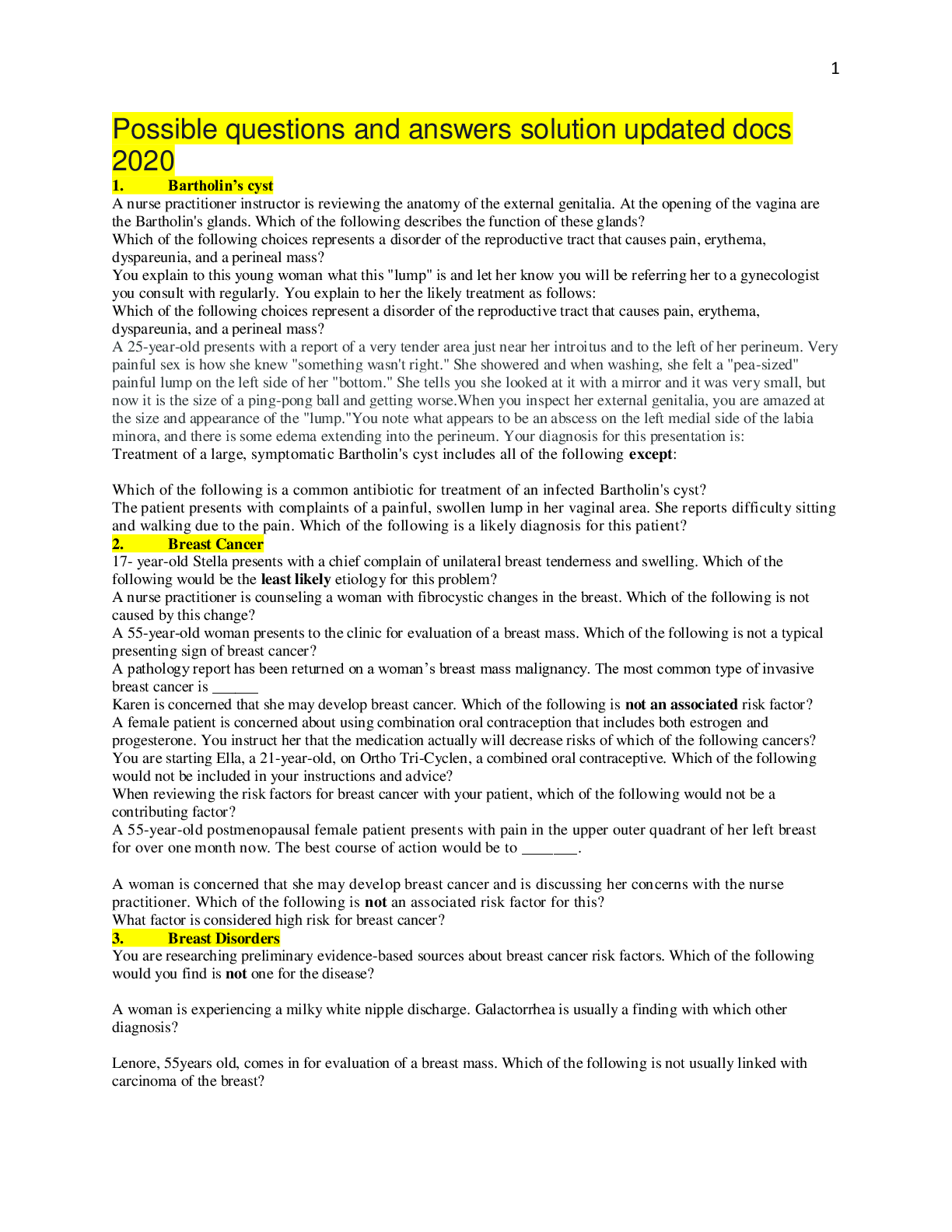BioChemistry > QUESTIONS & ANSWERS > Biochemistry Exam 1, 52 practice questions with correct answers. Questions with accurate answers, Ga (All)
Biochemistry Exam 1, 52 practice questions with correct answers. Questions with accurate answers, Garded A
Document Content and Description Below
Biochemistry Exam 1, 52 practice questions with correct answers In a bacterial cell, the DNA is in the: A) cell envelope. B) cell membrane. C) nucleoid. D) nucleus. E) ribosomes. >>>nucleoid A... major change occurring in the evolution of eukaryotes from prokaryotes was the development of: A) DNA. B) photosynthetic capability. C) plasma membranes. D) ribosomes. E) the nucleus >>>the nucleus In eukaryotes, the nucleus is enclosed by a double membrane called the: A) cell membrane. B) nuclear envelope. C) nucleolus. D) nucleoplasm. E) nucleosome. >>>nuclear envelope The dimensions of living cells are limited, on the lower end by the minimum number of biomolecules necessary for function, and on the upper end by the rate of diffusion of solutes such as oxygen. Except for highly elongated cells, they usually have lengths and diameters in the range of: A) 0.1 µm to 10 µm. B) 0.3 µm to 30 µm. C) 0.3 µm to 100 µm. D) 1 µm to 100 µm. E) 1 µm to 300 µm >>>0.3 µm to 100 µm The bacterium E. coli requires simple organic molecules for growth and energy—it is therefore a: A) chemoautotroph. B) chemoheterotroph. C) lithotroph. D) photoautotroph. E) photoheterotroph >>>chemoheterotroph Which one of the following has the cellular components arranged in order of increasing size?A) Amino acid < protein < mitochondrion < ribosome B) Amino acid < protein < ribosome < mitochondrion C) Amino acid < ribosome < protein < mitochondrion D) Protein < amino acid < mitochondrion < ribosome E) Protein < ribosome < mitochondrion < amino acid >>>Amino acid < protein < ribosome < mitochondrion The three-dimensional structure of macromolecules is formed and maintained primarily through noncovalent interactions. Which one of the following is not considered a noncovalent interaction? A) carbon-carbon bonds B) hydrogen bonds C) hydrophobic interactions D) ionic interactions E) van der Waals interactions >>>carbon-carbon bonds Which one of the following is not among the four most abundant elements in living organisms? A) Carbon B) Hydrogen C) Nitrogen D) Oxygen E) Phosphorus >>>Phosphorus The four covalent bonds in methane (CH4) are arranged around carbon to give which one of the following geometries? A) linear B) tetrahedral C) trigonal bipyramidal D) trigonal planar E) trigonal pyramidal >>>tetrahedral The macromolecules that serve in the storage and transmission of genetic information are: A) carbohydrates. B) lipids. C) membranes. D) nucleic acids. E) proteins >>>nucleic acids Stereoisomers that are nonsuperimposable mirror images of each other are known as: A) anomers. B) cis-trans isomers. C) diastereoisomers.D) enantiomers. E) geometric isomers >>>enantiomers The enzyme fumarase catalyzes the reversible hydration of fumaric acid to l-malate, but it will not catalyze the hydration of maleic acid, the cis isomer of fumaric acid. This is an example of: A) biological activity. B) chiral activity. C) racemization. D) stereoisomerization. E) stereospecificity. >>>stereospecificity Humans maintain a nearly constant level of hemoglobin by continually synthesizing and degrading it. This is an example of a(n): A) dynamic steady state. B) equilibrium state. C) exergonic change. D) free-energy change. E) waste of energy >>>dynamic steady state If heat energy is absorbed by the system during a chemical reaction, the reaction is said to be: A) at equilibrium. B) endergonic. C) endothermic. D) exergonic. E) exothermic >>>endothermic If the free energy change ∆G for a reaction is -46.11 kJ/mol, the reaction is: A) at equilibrium. B) endergonic. C) endothermic. D) exergonic. E) exothermic >>>exergonic The major carrier of chemical energy in all cells is: A) acetyl triphosphate. B) adenosine monophosphate. C) adenosine triphosphate. D) cytosine tetraphosphate. E) uridine diphosphate >>>adenosine triphosphate Enzymes are biological catalysts that enhance the rate of a reaction by: A) decreasing the activation energy. B) decreasing the amount of free energy released. C) increasing the activation energy.D) increasing the amount of free energy released. E) increasing the energy of the transition state >>>decreasing the activation energy Energy requiring metabolic pathways that yield complex molecules from simpler precursors are: A) amphibolic. B) anabolic. C) autotrophic. D) catabolic. E) heterotrophic >>>anabolic Hereditary information (with the exception of some viruses) is preserved in: A) deoxyribonucleic acid. B) membrane structures. C) nuclei. D) polysaccharides. E) ribonucleic acid. >>>deoxyribonucleic acid When a region of DNA must be repaired by removing and replacing some of the nucleotides, what ensures that the new nucleotides are in the correct sequence? A) DNA cannot be repaired and this explains why mutations occur. B) Specific enzymes bind the correct nucleotides. C) The new nucleotides base-pair accurately with those on the complementary strand. D) The repair enzyme recognizes the removed nucleotide and brings in an identical one to replace it. E) The three-dimensional structure determines the order of nucleotides. >>>The new nucleotides base-pair accurately with those on the complementary strand The three-dimensional structure of a protein is determined primarily by: A) electrostatic guidance from nucleic acid structure. B) how many amino acids are in the protein. C) hydrophobic interaction with lipids that provide a folding framework. D) modification during interactions with ribosomes. E) the sequence of amino acids in the protein. >>>the sequence of amino acids in the protein According to Oparin's theory for the origin of life, the prebiotic atmosphere: A) already contained some primitive RNA molecules. B) basically was very similar to the atmosphere of today. C) contained many amino acids. D) had an abundance of methane, ammonia, and water. E) was rich in oxygen. >>>had an abundance of methane, ammonia, and water What six characteristics distinguish living organisms from inanimate objects? >>>- are chemically complex and highly organized; - extract, transform, and use energy from their environment;- have the capacity to precisely self-replicate and self-assemble; - exploit a chemical interplay with their environment; - possess programmatically defined functions; and - evolve to new forms over many generations The chirality of an amino acid results from the fact that its α carbon: A) has no net charge. B) is a carboxylic acid. C) is bonded to four different chemical groups. D) is in the L absolute configuration in naturally occurring proteins. E) is symmetric. >>>is bonded to four different chemical groups Of the 20 standard amino acids, only ___________ is not optically active. The reason is that its side chain ___________. A) alanine; is a simple methyl group B) glycine; is a hydrogen atom C) glycine; is unbranched D) lysine; contains only nitrogen E) proline; forms a covalent bond with the amino group >>>glycine; is a hydrogen atom Two amino acids of the standard 20 contain sulfur atoms. They are: A) cysteine and serine. B) cysteine and threonine. C) methionine and cysteine D) methionine and serine E) threonine and serine. >>>methionine and cysteine All of the amino acids that are found in proteins, except for proline, contain a(n): A) amino group. B) carbonyl group. C) carboxyl group. D) ester group. E) thiol group. >>>amino group Which of the following statements about aromatic amino acids is correct? A) All are strongly hydrophilic. B) Histidine's ring structure results in its being categorized as aromatic or basic, depending on pH. C) On a molar basis, tryptophan absorbs more ultraviolet light than tyrosine. D) The major contribution to the characteristic absorption of light at 280 nm by proteins is the phenylalanine R group [Show More]
Last updated: 2 years ago
Preview 1 out of 10 pages

Buy this document to get the full access instantly
Instant Download Access after purchase
Buy NowInstant download
We Accept:

Reviews( 0 )
$8.00
Can't find what you want? Try our AI powered Search
Document information
Connected school, study & course
About the document
Uploaded On
Sep 21, 2022
Number of pages
10
Written in
Seller

Reviews Received
Additional information
This document has been written for:
Uploaded
Sep 21, 2022
Downloads
0
Views
100











